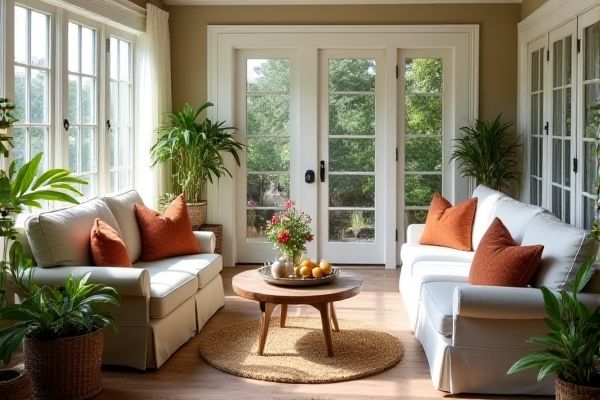
Reversible furniture in your sunroom offers flexibility by allowing you to change configurations based on mood or function, unlike fixed furniture which provides stability and a permanent layout. Discover the pros and cons of each option to choose the best fit for your sunroom's style and utility in the rest of this article.
Table of Comparison
| Feature | Reversible Furniture | Fixed Furniture |
|---|---|---|
| Flexibility | High - can be easily rearranged or moved | Low - permanently installed, limited rearrangement |
| Installation | Simple, no structural changes required | Requires professional installation and structural modification |
| Durability | Moderate - designed for mobility, may wear faster | High - built for long-term use and stability |
| Cost | Typically lower initial cost | Higher initial cost due to customization and installation |
| Maintenance | Easy to clean and maintain | May require periodic professional upkeep |
| Space Optimization | Adaptable to changing space needs | Fixed layout may limit space adjustments |
| Design Options | Variety of styles, limited customization | Highly customizable to match sunroom design |
| Resale Value | Lower impact on property value | Can increase property value with quality installation |
Introduction to Sunroom Furniture Choices
Sunroom furniture options include reversible and fixed pieces, each offering unique benefits for your space. Reversible furniture provides versatility by allowing you to change its configuration or orientation to suit different needs or styles. Fixed furniture is designed for stability and permanence, often enhancing the sunroom's aesthetic with custom or built-in pieces tailored to the room's dimensions.
What is Reversible Furniture?
Reversible furniture in sunrooms features designs that allow pieces to be easily flipped, rotated, or reconfigured to serve multiple functions or adapt to changing spaces, enhancing versatility and maximizing usability. Unlike fixed furniture, which remains static and occupies a predetermined layout, reversible furniture offers dynamic flexibility, making it ideal for seasonal changes or various activities in sunroom environments. This adaptability ensures optimal space utilization and increased comfort without the need for permanent alterations.
What is Fixed Furniture?
Fixed furniture in a sunroom refers to built-in installations that are permanently attached to the structure, such as benches, cabinets, or shelving units. This type of furniture maximizes space efficiency and offers seamless integration with the room's design, providing durability and stability. Your choice of fixed furniture enhances the sunroom's functionality while maintaining a clean, organized aesthetic.
Design Flexibility: Reversible vs Fixed Options
Reversible furniture in sunrooms offers unparalleled design flexibility, allowing users to rearrange or repurpose pieces to match changing needs, seasons, or aesthetic preferences. Fixed furniture, while providing stability and a defined layout, limits adaptability and may not accommodate evolving spatial arrangements or multifunctional uses. Opting for reversible options enhances customization and prolongs functional lifespan by supporting diverse interior design changes over time.
Space Optimization in Sunrooms
Reversible furniture in sunrooms maximizes space optimization by allowing easy rearrangement to suit different needs and activities, enhancing flexibility in limited areas. Fixed furniture often occupies permanent space, limiting adaptability but providing stable, custom-fitted solutions that maximize every inch of the sunroom. Selecting reversible options enables multifunctional use, while fixed furniture offers a tailored approach to space optimization depending on user priorities.
Cost Comparison: Reversible vs Fixed Furniture
Reversible furniture in a sunroom often costs more upfront due to its versatile design and multi-functional materials, offering long-term savings by adapting to changing needs without replacement. Fixed furniture typically has a lower initial cost but may require more frequent updates or replacements as style or functionality preferences evolve. Your investment in reversible furniture can lead to greater value over time by maximizing flexibility and reducing the need for additional purchases.
Aesthetic Appeal and Style Variations
Reversible furniture in a sunroom offers versatile aesthetic appeal, allowing You to easily switch styles and layouts to match changing tastes or seasonal decor. Fixed furniture provides a consistent, cohesive look with carefully curated design elements, ensuring stability and a uniform style throughout the space. Both options cater to different preferences, with reversible pieces offering dynamic style variations while fixed furniture emphasizes timeless elegance.
Durability and Maintenance Considerations
Reversible furniture in sunrooms offers enhanced durability through materials designed to withstand temperature fluctuations and humidity changes, reducing wear and tear over time. Fixed furniture often requires more frequent maintenance due to its permanent installation, which can be susceptible to damage from prolonged sun exposure and moisture buildup. Choosing reversible furniture simplifies upkeep and extends the lifespan of sunroom furnishings by allowing seasonal adjustments and easier cleaning.
Best Use Cases for Each Furniture Type
Reversible furniture in sunrooms offers flexibility for seasonal changes and varied seating arrangements, making it ideal for spaces where you want to frequently update the layout or maximize comfort during different weather conditions. Fixed furniture suits sunrooms that serve as permanent, dedicated relaxation or dining areas, providing sturdy, space-efficient setups that complement a consistent design style. Choosing the right furniture type depends on Your sunroom's primary function and how often You plan to reconfigure the space.
Choosing the Right Solution for Your Sunroom
Reversible furniture offers flexibility and adaptability for your sunroom, allowing you to easily rearrange pieces to suit changing needs or seasonal decor. Fixed furniture provides stability and often maximizes space efficiency with built-in storage or attached features tailored to the area's dimensions. Selecting between reversible and fixed furniture depends on your sunroom's size, usage, and your preference for versatility versus permanence.
 homyna.com
homyna.com